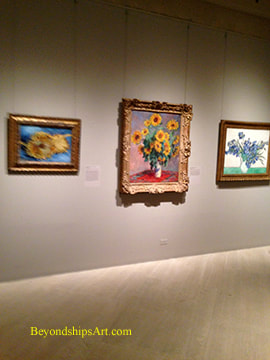 “Public Parks, Private Gardens: Paris to Provence” at the Metropolitan Museum of Art is a large exhibition that places in context much of the art created in France from the French Revolution to World War I. It explains why so much attention was paid by artists such as the Impressionists to the out doors as a subject. Extending from the late 18th century through the 19th century a passion developed in France for parks and gardens. Several factors came together to fuel this passion. First, as a result of the French Revolution, the parks and hunting reserves that had heretofore been open only to royalty and the aristocracy, became open to everyone. This access helped to open the eyes of the public to the beauties of nature. Second, the Industrial Revolution also changed the character of society. The middle class grew and people had more leisure time. They wanted green spaces, both public parks and private gardens, where they could escape from the stresses and pollution that were the less attractive side effects of industrialization. Accordingly, in the grand re-design of Paris that took place in the mid-19th century, Baron Haussmann included tree-lined boulevards and some 30 parks and squares. Other cities and towns throughout France followed suit. Third, it was also a period of exploration and travel. Exotic plants were being brought back to France, stirring the public imagination. The Empress Josephine, first wife of Napoleon, and a celebrity in her day, spurred public interest in such plants by making her greenhouse at Malmaison a horticulture hub for exotic species. Artists were not immune from these forces. The natural world, depicted in landscapes and in still lifes, had long been a subject for art. However, a new enthusiaum developed. The painters of the Barbizon School took inspiration from the former royal hunting grounds at Fontainebleau. Later, the Impressionists, whose aims included depicting scenes of modern life, reflected public's passion for parks, gardens and the natural world in their works. While this exhibition includes earlier works, the Impressionists and the artists that they influenced dominate the exhibition. For example, in the gallery “Parks for the Public,” we see works by Camille Corot, Théodore Rousseau and others of former royal hunting reserves. However, you also have masterpieces by Calude Monet and Camille Pissaro of city parks in Paris. There is also a wonderful watercolor by Berthe Morrisot “A Woman Seated at a Bench on the Avenue du Bois” as well as a study by Pointillist George Seurat for “"A Sunday on La Grande Jatte." In the gallery “Private Gardens,” the works reflect the fact that people wanted to have their own green spaces where they could cultivate plants and escape from the outside world. Many artists were also amateur gardeners during this period. Of course, the dominant figure here is Claude Monet who was painting garden scenes long before he created his famous garden at Giverney. However, lesser known watercolors of garden scenes by Renoir and by Cezanne should not be overlooked. With regard to portraiture, we see that the artists blurred the distinction between portraits and genre painting. They are both depictions of individuals and scenes of everyday life. As a result, the identity of the sitter is no longer paramount if important at all to the success of the work. Furthermore, nature is an equal partner in these scenes, not just a background. To illustrate, Edouard Manet's “The Monet Family in Their Garden at Argenteuil” is a portrait of Monet and his family. The figures are arranged in a relaxed manner rather than in traditional portrait poses. Thus, it is also a scene of everyday life. Moreover, it would be just as successful if the figures were an unidentified family because it is a captivating garden scene. The passion for nature also brought about a revival of interest in floral still life painting. The exhibition presents examples by Manet, Monet, Cassat, Degas, and Matisse to name a few. But Vincent Van Goghs paintings of sunflowers and irises attract the most viewers. Given the popularity of the Impressionists and their broader circle, one would expect any exhibit in which they are prominent to be successful. However, the Met has done a good job here of supporting the theme of the exhibition. In addition to the paintings, there are drawings, prints contemporary photographs and objects relating to this theme. The signage is also good. Comments are closed.
|
AuthorRich Wagner is a writer, photographer and artist. Archives
November 2018
Categories
All
|
 RSS Feed
RSS Feed